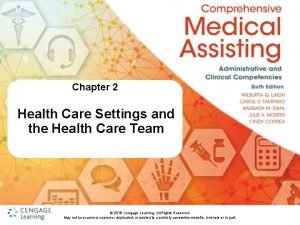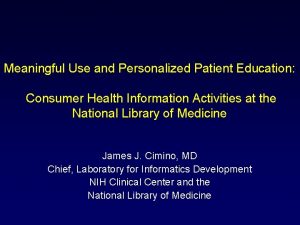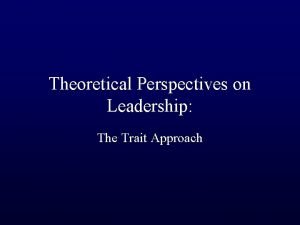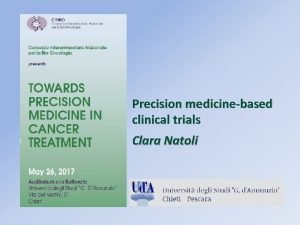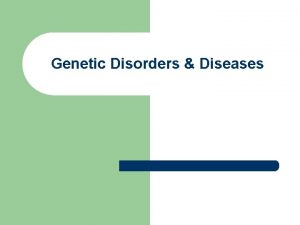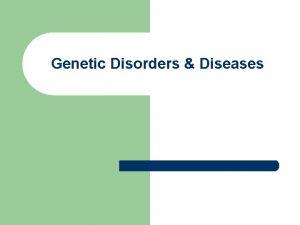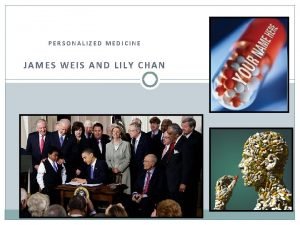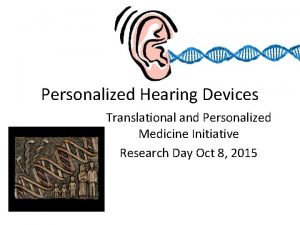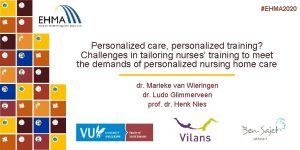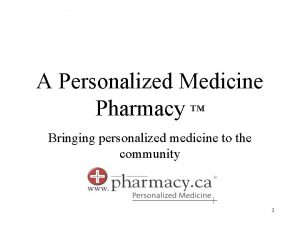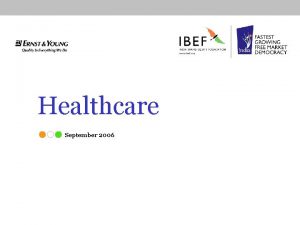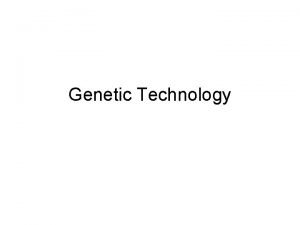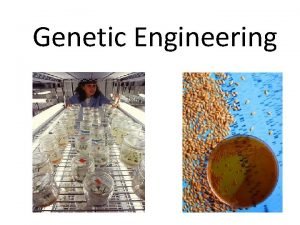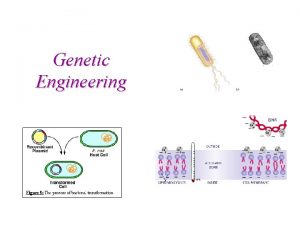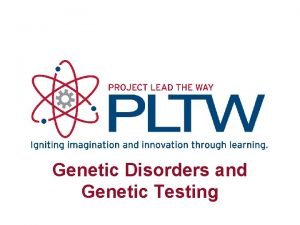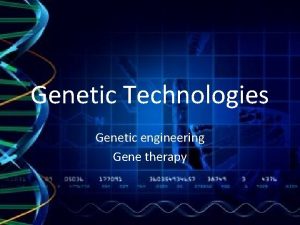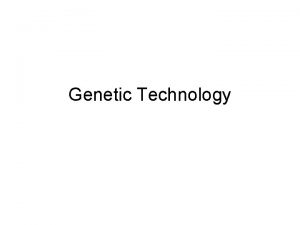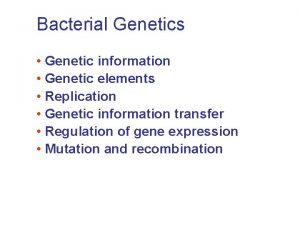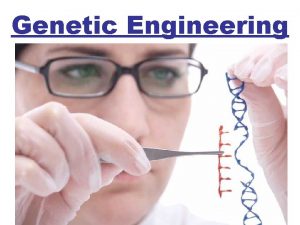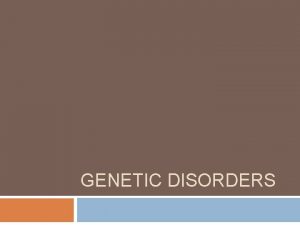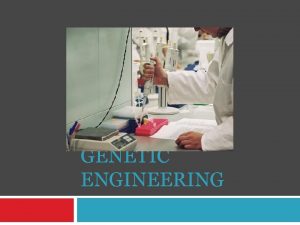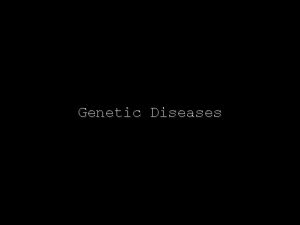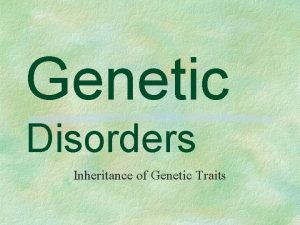Genetic DisordersDiseases Healthcare Personalized for You Week 5











































- Slides: 43

Genetic Disorders/Diseases Healthcare Personalized for You Week 5 May 16, 2017 Beth Balkite & Rachel Mills Duke OLLI Spring 2017

Week 5 • Mental Health Disorders • Heart Disease • Cancer Beth Balkite & Rachel Mills Duke OLLI Spring 2017

Mental Health Disorders Beth Balkite & Rachel Mills Duke OLLI Spring 2017

Mental Health Disorders • Complex medical conditions = Multiple genetic risk factors + environment contribute to onset of diseases • No specific gene has been unambiguously identified for common forms of mental disorders • Critical role of the environment in modulating genetic susceptibility in mental disorders • Twin studies indicate that individuals with same genes do not always get the same mental health disorders. • If twins with the same genes do not both have the disorder, there is strong evidence for the role of environmental factors. Beth Balkite & Rachel Mills Duke OLLI Spring 2017

Genetics of Mental Health Disorders • Mental health symptoms are associated with uncommon single-gene disorders • Example: 22 q 11 deletion syndrome and schizophrenia • Studying genetics of mental health is very challenging • Researchers have trouble discriminating specific forms of mental disorders (i. e. distinguishing someone experiencing depression as part of a depressive disorder from someone experiencing depression as part of bipolar disorder) • A given susceptibility gene may or may not result in the disorder • Various combinations of genes may all lead to the same disorder • At present, no genetic tests exist that can establish, confirm, or refine a psychiatric diagnosis Beth Balkite & Rachel Mills Duke OLLI Spring 2017

Depression • Also known as “major depressive disorder” • 10 -15% of general population will experience clinical depression • 5% of men and 9% of women experience a depressive disorder each year • Twin studies suggest a heritability of 40% to 50%, and family studies indicate a twofold to threefold increase in lifetime risk of developing MDD among first-degree relatives • Gene identification has been difficult • No single gene is necessary and sufficient for disease onset • Each susceptibility gene contributes a small fraction of the total genetic risk • Multiple overlapping sets of susceptibility genes can predispose individuals to similar syndromes that are indistinguishable on clinical grounds. • Gene studies of unipolar depression have received less attention compared to bipolar and schizophrenia Beth Balkite & Rachel Mills Duke OLLI Spring 2017

Genetics of Depression • Over 80 SNPs listed in the Promethease database, but few are based on multiple references or considered of good repute • Likelihood of disease onset • COMT – variable evidence relating to disease risk, stronger association with effects on response to antidepressants • FKBP 5 – variable evidence relating to disease risk, specific SNPs appear to be associated with disease onset • Medication response • SLC 6 A 4 – serotonin transporter gene • HTR 2 A – serotonin receptor, associated with response to citalopram Beth Balkite & Rachel Mills Duke OLLI Spring 2017

Bipolar Disease • Also known as manic-depressive illness • Unusual shifts in mood, energy, activity levels, and the ability to carry out day-to-day tasks • Twin studies • Monozygotic (identical) twin of a person with schizophrenia has a 60 to 80 percent chance of also having the disorder. • Dizygotic (fraternal) twin has only a 8 percent chance of having the disorder Beth Balkite & Rachel Mills Duke OLLI Spring 2017

Genetics of bipolar disorder • About 100 SNPs included in Promethease • rs 420259 in gene PALB 2 • rs 4713902 in gene FKBP 5 • rs 1006737 in gene CACNA 1 C – also associated with increased risk of depression and schizophrenia • ANK 3 – increased expression in individuals with bipolar and schizophrenia • Testing available for GRK 3 but it is not validated and not recommended Beth Balkite & Rachel Mills Duke OLLI Spring 2017

Schizophrenia • Mental disorder that alters sufferers’ perception of reality, producing delusions, hallucinations, and disordered thinking. • Risk factors: family history of schizophrenia, malnutrition or exposure to viruses in the womb, stressful life circumstances, taking psychoactive drugs during adolescence • About 2. 4 million American adults (1. 1% of the adult U. S. population) have schizophrenia • Twin studies: • Monozygotic (identical) twin of a person with schizophrenia has a 46 percent chance of being affected • Dizygotic (fraternal) twin has only a 14 percent chance of being affected Beth Balkite & Rachel Mills Duke OLLI Spring 2017

Genetics of schizophrenia • Copy number variations associated with schizophrenia Copy number variation • Sections of the genome that are repeated, can result in creation of abnormal protein that interferes with development of brain cells • Over 180 SNPs listed in Promethease • rs 1344706 in the gene ZNF 804 A • rs 2269726, in the gene GNB 1 L – applicable in individuals of Asian ancestry • ANF 804 A Beth Balkite & Rachel Mills Duke OLLI Spring 2017

Pharmacogenomics for Mental Health Disorders • Finding the right medication for mental health disorders is challenging • 50% of patients with depression don’t respond to their first treatment • 30% of patient discontinue medication because of side effects • Up to 70% of patients are non-adherent, mostly due to side effects • Pharmacogenes • CYP 2 D 6 for Selective Serotonin Reuptake Inhibitors (SSRIs) like paroxetine (Paxil) and fluvoxamine (Luvox) • CYP 2 C 19 for SSRIs like citalopram (Celexa), escitalopram (Lexapro), and sertraline (Zoloft) • CYP 2 C 19 for Tricyclics (TCA) liks amitriptyline (Elavil) • CYP 2 D 6 for TCAs like nortriptyline (Pamelor), doxepin (Silenor, Zonalon, and Prudoxin), desipramine (Norpramin), clomipramine (Anafranil), Beth Balkite & Rachel Mills Duke OLLI Spring 2017

Heart Disease Beth Balkite & Rachel Mills Duke OLLI Spring 2017

Heart Disease = Complex Disease and Complex Genetics • Heart disease affects over 80, 000 individuals in the US • Heart Disease encompasses a broad range of disorders: • • Diseases of the vasculature Diseases of the myocardium (muscles of the heart) Heart’s electrical circuit Congenital heart disease • For nearly all of these disorders, inherited DNA sequence variants play a role in conferring risk for disease. • For example, in the general population, a history of heart disease in a parent confers about 3. 0 x greater increase risk to offspring • Two or more first degree relatives = 5 x greater risk Beth Balkite & Rachel Mills Duke OLLI Spring 2017

Heart Disease: Promethease • The most highly replicated associations to heart disease have been to SNPs in the chromosome 9 p 21 region • SNPs in this region include: • • Rs 2383206* rs 10757278 rs 2383207 Rs 10757274* • *SNPs can double the risk of heart disease • About one in every four Caucasians are thought to carry the gene variants associated with heart disease • Rs 10757274* is also associated with T 1 Diabetes Beth Balkite & Rachel Mills Duke OLLI Spring 2017

Causes of Heart Disease • Abnormalities in the heart structure • Abnormalities in proteins, biochemicals impacting heart functions Beth Balkite & Rachel Mills Duke OLLI Spring 2017

Heart Disease: Structure of the Heart Familial hypertrophic cardiomyopathy • Heart condition characterized by thickening of the heart muscle • Thickening usually occurs in the inter-ventricular septum, which is the muscular wall that separates the lower left chamber of the heart (the left ventricle) from the lower right chamber (the right ventricle) • Symptoms • Thickening of the inter-ventricular septum slows the flow of oxygen-rich blood from the heart, which may lead to an abnormal heart sound during a heartbeat (heart murmur) • Other affected individuals do not have physical obstruction of blood flow, but the pumping of blood is less efficient, which can also lead to symptoms of the condition such as chest pain, shortness of breath, lightheadedness, dizziness, and fluttering or pounding of the chest • Cardiac hypertrophy often begins in adolescence or young adulthood, although it can develop at any time throughout life. • The symptoms of familial hypertrophic cardiomyopathy are variable, even within the same family. Beth Balkite & Rachel Mills Duke OLLI Spring 2017

Genetics of Hypertrophic Cardiomyopathy • Mutations in one of several genes can cause familial hypertrophic cardiomyopathy • Most commonly involved genes are MYH 7, MYBPC 3, TNNT 2, and TNNI 3 • These genes have important roles in producing the proteins involved in the contraction of the heart muscle • Autosomal dominant inheritance: one copy of the gene can cause disease • Often one parent is affected; occasionally no history, person represents a new mutation Beth Balkite & Rachel Mills Duke OLLI Spring 2017

Heart Disease: Structure of the Heart Familial dilated cardiomyopathy • Occurs when heart (cardiac) muscle becomes thin and weakened in at least one chamber of the heart, causing the open area of the chamber to become enlarged (dilated) • As a result, the heart is unable to pump blood as efficiently as usual. • To compensate, the heart attempts to increase the amount of blood being pumped through the heart, leading to further thinning and weakening of the cardiac muscle. • Over time, this condition results in heart failure. • It usually takes many years for symptoms of familial dilated cardiomyopathy to cause health problems. • They typically begin in mid-adulthood, but can occur at any time from infancy to late adulthood. • Signs and symptoms of familial dilated cardiomyopathy can include an irregular heartbeat (arrhythmia), shortness of breath (dyspnea), extreme tiredness (fatigue), fainting episodes (syncope), and swelling of the legs and feet. • In some cases, the first sign of the disorder is sudden cardiac death. • The severity of the condition varies among affected individuals, even in members of the same family. Beth Balkite & Rachel Mills Duke OLLI Spring 2017

Genetics of Dilated Cardiomyopathy • Mutations in more than 30 genes have been found to cause familial dilated cardiomyopathy • These genes provide instructions for making proteins that are found in cardiac muscle cells • Mutations in one gene, TTN, account for approximately 20% of cases of familial dilated cardiomyopathy. • The TTN gene provides instructions for making a protein called titin, which is found in the sarcomeres of many types of muscle cells, including cardiomyocytes. • Familial dilated cardiomyopathy has different inheritance patterns depending on the gene involved. • In 80 to 90 percent of cases, familial dilated cardiomyopathy is inherited in an autosomal dominant pattern • In most cases, an affected person inherits the mutation from one affected parent • Some people who inherit the altered gene never develop features of familial dilated cardiomyopathy (reduced penetrance. ) • Other cases result from new mutations in the gene and occur in people with no history of the disorder in their family. • Autosomal recessive and X-linked recessive cases have been reported Beth Balkite & Rachel Mills Duke OLLI Spring 2017

Cardiomyopathies Beth Balkite & Rachel Mills Duke OLLI Spring 2017

Heart Disease: Rhythm • Long QT syndrome (LQTS) is a heart rhythm condition that can potentially cause fast, chaotic heartbeats • Rapid heartbeats trigger a sudden fainting spell or seizure. In some cases, the heart can beat erratically for so long that it causes sudden death. • You can be born with a genetic mutation that puts you at risk or certain medications and medical conditions might cause long QT syndrome. • Long QT syndrome is treatable with certain medications, surgery or an implantable device • Can prevent episodes by avoiding medications known to cause prolonged QT and certain physical activities or sports may need to be avoided Beth Balkite & Rachel Mills Duke OLLI Spring 2017

Genetics: Long QT • At least 17 genes associated with long QT syndrome have been discovered so far, and hundreds of mutations within these genes have been identified. • Mutations in three of these genes account for about 75 percent of long QT syndrome cases, while mutations in the other 14 minor genes contribute less than 5 percent of long QT syndrome cases. • Genes most commonly involved are KCNQ 1(leading to Long QT syndrome 1, aka LQT 1), KCNH 2 (LQT 2), and SCN 5 A (LQT 3) • Mutations in any of these three genes are considered important enough by the ACMG to warrant reporting to any person who's DNA sequence reveals them incidentally • Inheritance pattern: autosomal dominant; recessive when seen with deafness too • About 20% of people who have Long QT have a negative genetic test result Beth Balkite & Rachel Mills Duke OLLI Spring 2017

Structure: Congenital Heart Disease (CHD) • Congenital heart disease (CHD) is a term that refers to a group of serious heart defects that are present from birth • These abnormalities result from problems with the formation of one or more parts of the heart during the early stages of embryonic development. • CHD prevents the heart from pumping blood effectively or reduces the amount of oxygen in the blood • 18/10, 000 births • Run in families therefore increased risk if first degree relative is affected Beth Balkite & Rachel Mills Duke OLLI Spring 2017

Heart Disease: Biochemical Cholesterol • A waxy lipid used for hormones, vitamin D, and other biological needs • Packaged in lipoproteins: low-density lipoproteins (LDL) and high-density lipoproteins (HDL). • HDL decreases risks of heart disease (good cholesterol) • HDL carries cholesterol and phospholipids through the bloodstream from the body's tissues to the liver to be redistributed to other tissues or removed from the body • This process balances cholesterol levels and maintaining cardiovascular health • High levels of HDL reduce the chances of developing heart and blood vessel (cardiovascular) disease • LDL increases risks of heart disease (bad cholesterol) • Diet, activity and genetics affect plasma lipoprotein levels • Many Genes and SNP have been associated with HDL cholesterol and LDL cholesterol concentrations, including: rs 6544713, rs 7679, rs 2271293 Beth Balkite & Rachel Mills Duke OLLI Spring 2017

Genetics of LDL: “Bad Cholesterol” Familial hypercholesterolemia (abbreviated FH) is a genetic disorder characterized by high levels of LDL ("bad cholesterol") in the blood and early cardiovascular disease • Caused by mutations in the LDLR gene that encodes the LDL receptor protein • Normally removes LDL from the circulation • Heterozygous FH: People who have one abnormal copy of the LDLR gene • • Inherited in an autosomal dominant pattern Develop cardiovascular disease prematurely at the age of 30 to 40 Common genetic disorder occurring in 1: 500 people in most countries Normally treated with statins or other agents that lower cholesterol levels. • Homozygous FH: Having two abnormal copies of LDLR gene • Causes severe cardiovascular disease in childhood. • Very rare, occurring in 1 in a million births • Often does not respond to medical therapy and may require other treatments, including LDL apheresis (removal of LDL in a method similar to dialysis) or liver transplantation Beth Balkite & Rachel Mills Duke OLLI Spring 2017

Genetics of HDL: “Good cholesterol” • ABCA 1 gene provides instructions for making proteins that transport molecules across cell membranes. • These substances are transported by the protein apolipoprotein A-I (apo. A-I) (coded by the APOA 1 gene) • Apo. A-I, cholesterol, and phospholipids combine to make HDL • Familial HDL deficiency • Caused by Mutations in ABAC 1 & APOA 1 • Reduced levels of HDL in their blood and may experience early-onset cardiovascular disease, often before age 50 • Most ABCA 1 mutations change single protein building blocks, preventing the release of cholesterol and phospholipids from cells, decreasing the amount of these substances available to form HDL • One copy of the altered ABCA 1 gene causes familial HDL deficiency, two copies of the altered gene cause a more severe related disorder called Tangier disease Beth Balkite & Rachel Mills Duke OLLI Spring 2017

Congestive Heart Failure • Congestive heart failure (CHF) remains the single most common cause of mortality and morbidity in the developed world: 5 million hospitalizations annually • Results in part from inherited variation in myocardial, vascular and other responses • Underlying traits responsible for the ultimate development of heart failure are unclear • There is currently no genetic testing available or SNPs reported to be associated directly with CHF Beth Balkite & Rachel Mills Duke OLLI Spring 2017

Heart Disease: Myocardial Infarct • Myocardial infarction (MI) or acute myocardial infarction (AMI), commonly known as a heart attack, occurs when blood flow stops to a part of the heart causing damage to the heart muscle • Symptoms • The most common symptom is chest pain or discomfort which may travel into the shoulder, arm, back, neck, or jaw • Often it is in the center or left side of the chest and lasts for more than a few minutes • The discomfort may occasionally feel like heartburn • Other symptoms may include shortness of breath, nausea, feeling faint, a cold sweat, or feeling tired • Women more often have atypical symptoms than men • Most MIs occur due to coronary artery disease • Risk factors include high blood pressure, smoking, diabetes, lack of exercise, obesity, high blood cholesterol, poor diet, and excessive alcohol intake, • The mechanism of an MI often involves the complete blockage of a coronary artery caused by a rupture of an atherosclerotic plaque Beth Balkite & Rachel Mills Duke OLLI Spring 2017

Genetics of MI • Increased risk for MI when there is a family history of ischemic heart disease or MI • Particularly if one has a first-degree relative who had a 'premature' MI (defined as occurring at or younger than age 55 years for men or 65 for women) • Genome-wide association studies have found 27 genetic variants that are associated with an increased risk of myocardial infarction • The strongest association 9 p 21 genomic locus, which contains genes CDKN 2 A & CDKN 2 B, • SNPs that are implicated are within a non-coding region • The majority of variants are in regions that have not been previously implicated in coronary artery disease. • The following genes have an association with MI: • PCSK 9, SORT 1, MIA 3, WDR 12, MRAS, PHACTR 1, LPA, TCF 21, MTHFDSL, ZC 3 HC 1, CDKN 2 A, 2 B, ABO, PDGF 0, AP OA 5, MNF 1 ASM 283, COL 4 A 1, HHIPC 1, SMAD 3, ADAMTS 7, RAS 1, SMG 6, SNF 8, LDLR, SLC 5 A 3, MRPS 6, KCNE 2 • Promethease reports over two dozen SNPs associated with the genes involved in MI • Mutations in these genes are often inherited in an autosomal dominant pattern (one copy causes the disease) Beth Balkite & Rachel Mills Duke OLLI Spring 2017

Cardiology and pharmacogenetics • Many cardiac diseases are treated by medications with variable response based on pharmacogenes • CYP 2 C 19 & clopidogrel • CYP 2 D 6 & carvedilol • CYP 2 D 6 & propafenone • CYP 2 C 9/VKORC 1 & warfarin • SLCO 1 B 1 & simvastatin Beth Balkite & Rachel Mills Duke OLLI Spring 2017

Cancer Beth Balkite & Rachel Mills Duke OLLI Spring 2017

Genomics of Cancer • “Cancer is a disease of the genome” • Types of cancer genes • Oncogenes – proto-oncogenes help cells grow, but when it has a mutation it becomes an oncogene and causes the cell to grow out of control • Mostly acquired mutations, chromosome rearrangements, gene duplication • Examples of inherited oncogene: RAS • Tumor suppressors – genes that slow down division, repair DNA mistakes, or tells cells when to die • Examples of inherited tumor suppresors: p 53, BRCA 1 Beth Balkite & Rachel Mills Duke OLLI Spring 2017

Environmental effects and cancer • Carcinogenic exposures (carcinogens) are “mutation makers” • cigarettes, chewing tobacco, UV exposures, cosmic rays, radiation, benzene, asbestos • Oncogenic viruses • HPV/cervical cancer, hepatitis C/liver cancer, Epstein Barr/head and neck cancer Beth Balkite & Rachel Mills Duke OLLI Spring 2017

Beth Balkite & Rachel Mills Duke OLLI Spring 2017


Beth Balkite & Rachel Mills Duke OLLI Spring 2017

Hereditary Breast & Ovarian Cancer • Incidence • 1 in 500 to 1 in 1000 in general pop • May be as high as 2% in Ashkenazi Jews • Accounts for about 5% of all breast cancer • Autosomal dominant inheritance with penetrance as high as 85% • Hundreds of mutations found in both genes • BRCA 1 gene • Female breast cancer risk is 47 -66%, ovarian cancer risk is 35 -46% • Male breast cancer risk is 1 -2%, estimated 3 x risk of prostate cancer • Increased risk for other cancers like stomach, pancreatic, colon • BRCA 2 gene • Female breast cancer risk is 40 -57%, ovarian cancer risk is 13 -23% • Male breast cancer risk 7%, estimated 3 x risk of prostate cancer • Increased risk for other cancers like throat, pancreatic, colon, melanoma Beth Balkite & Rachel Mills Duke OLLI Spring 2017

Colon cancer • Lynch syndrome • Accounts for 10% of colon cancer • Increased risk for other cancers like endometrium/uterine, ovary, stomach, urinary tract • Mutations in genes MLH 1, MSH 2, MSH 6, PMS 2 • Tumor testing can indicate whether cancer is hereditary syndrome • Familial Adenomatous Polyposis (FAP) • Mutations in gene APC Beth Balkite & Rachel Mills Duke OLLI Spring 2017

Other types of heritable cancers • Multiple endocrine neoplasia • Retinoblastoma • von Hippel-Lindau • Neurofibromatosis (NF 1) • Promethease includes cancer risk SNPs for number of cancers: • Bladder, breast, cervical, colon, endometrial, gastric, liver, ovarian, prostate, skin, etc • These have low impact! Clinical intervention should not be pursued based on those SNPs • Be sure to follow standard screening and prevention recommendations Beth Balkite & Rachel Mills Duke OLLI Spring 2017

Personalized treatment • Each tumor is unique • Recurrence risk • Oncotype DX test to predict the risk of recurrence in patients with ER+, nodenegative breast cancer treated with tamoxifen. • Targeted cancer therapy based on genetics of tumor • Test EGFR gene for treatment of lung cancer with erlotinib • Test for Philadelphia chromosome for treatment of leukemia and other cancers with imatinib (Gleevec) • Tumor has to be tested for genetic variation before prescribed Beth Balkite & Rachel Mills Duke OLLI Spring 2017

Next week: Beth Balkite & Rachel Mills Duke OLLI Spring 2017

Final Week of Class • Promethease • Pros and cons • How to use the site • How to get the most from the site • Precision Medicine Initiative • Resources: articles and Apps • A Look to the Future • Evaluations • Q and A Beth Balkite & Rachel Mills Duke OLLI Spring 2017
 Founder effect genetic drift
Founder effect genetic drift Genetic programming vs genetic algorithm
Genetic programming vs genetic algorithm Genetic programming vs genetic algorithm
Genetic programming vs genetic algorithm Gene flow vs genetic drift
Gene flow vs genetic drift Genetic drift vs genetic flow
Genetic drift vs genetic flow Healthcare and the healthcare team chapter 2
Healthcare and the healthcare team chapter 2 Healthcare and the healthcare team chapter 2
Healthcare and the healthcare team chapter 2 Week by week plans for documenting children's development
Week by week plans for documenting children's development Sigir 2018
Sigir 2018 Personalized mobile search engine ieee paper
Personalized mobile search engine ieee paper Pentaho business analytics integrations
Pentaho business analytics integrations Personalized patient education
Personalized patient education Contextual bandits for personalized recommendation
Contextual bandits for personalized recommendation Personalized recommendations
Personalized recommendations Personalized navigation
Personalized navigation Personal statement first draft
Personal statement first draft All to one reduction
All to one reduction Limitations of trait theory of leadership
Limitations of trait theory of leadership Personalized social stories
Personalized social stories Personalized learning learner profile
Personalized learning learner profile Mdanderson.org
Mdanderson.org Personalized cybersecurity
Personalized cybersecurity Institute for personalized learning
Institute for personalized learning Fspos
Fspos Typiska drag för en novell
Typiska drag för en novell Tack för att ni lyssnade bild
Tack för att ni lyssnade bild Ekologiskt fotavtryck
Ekologiskt fotavtryck Varför kallas perioden 1918-1939 för mellankrigstiden
Varför kallas perioden 1918-1939 för mellankrigstiden En lathund för arbete med kontinuitetshantering
En lathund för arbete med kontinuitetshantering Särskild löneskatt för pensionskostnader
Särskild löneskatt för pensionskostnader Vilotidsbok
Vilotidsbok Sura för anatom
Sura för anatom Densitet vatten
Densitet vatten Datorkunskap för nybörjare
Datorkunskap för nybörjare Stig kerman
Stig kerman Mall för debattartikel
Mall för debattartikel För och nackdelar med firo
För och nackdelar med firo Nyckelkompetenser för livslångt lärande
Nyckelkompetenser för livslångt lärande Påbyggnader för flakfordon
Påbyggnader för flakfordon Vätsketryck formel
Vätsketryck formel Publik sektor
Publik sektor Lyckans minut erik lindorm analys
Lyckans minut erik lindorm analys Presentera för publik crossboss
Presentera för publik crossboss Vad är ett minoritetsspråk
Vad är ett minoritetsspråk





